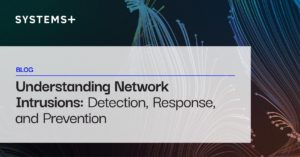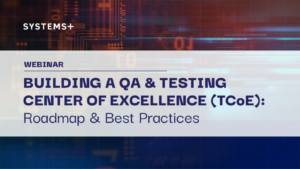How virtual captives could enable and sustain digital transformation


With
Managing Partner at Versitae
Enabling digital is leveraging technology to create new business models, new products and services, new strategies, and to ultimately drive business growth.
The podcast series explores how CIOs can capture opportunities by looking at and beyond technology and data to propel their organizations into the digital forefront.
The podcast series looks at how independent thought leaders and visionaries from the tech industry across the globe bring their ideas to scale within the business world, sharing innovative, path-breaking insights with our listeners.
We interview experts on trends and best practices for IT leaders. Sapan Choksi, CEO at Systems Plus, talks monthly with tech thought leaders on 21st business topics like innovation, digital transformation, AI, and automation.
We are excited to be in conversation with Eric Gordon on ‘How virtual captives could enable and sustain digital transformation’, as part of our Enabling Digital podcast series.
Eric is a strategic technology advisor, board member, and Managing Partner at Versitae, a Virtual Captive IT outsourcing company.
Eric spent many years working as a CIO. If there is one common thread he’s seen, it’s that the value of Information Technology is only as good as the people working on it.
Many growing companies don’t realize that finding their most ideal IT team isn’t something they have to do on their own.
As someone who has transformed many IT organizations, he has learned that the Virtual Captive IT sourcing model is the most cost-effective solution to this challenge. Eric’s mission is to help growing companies understand the value of smarter outsourcing.
Versitae is leading the charge on a new and improved way to “insource” IT talent. Insourcing is the shift in service delivery from a third-party outsourcing model – referred to as legacy offshoring – and to an in-house model – known as “Virtual Captive”.
The Virtual Captive approach allows companies to source the specific talent they need both now and in the future – saving them time, overhead, and stress.
: https://www.linkedin.com/in/ericgordon01/ : www.versitae.com/
Sapan Choksi 0:01
Hey everyone, a big hello to all our listeners. Today we're gonna be covering digital transformation. As you all know, digital transformation has become a buzzword of sorts today. However, it means different things to different people. I, today am joined by Eric Gordon, a former CIO and entrepreneur, and an advisor to firms currently undertaking their IT transformation journey. Very exciting to have your today. He's going to help us understand this whole digital transformation thing better. Eric, let's just dive right into it. And first of all, thank you so much for being here.
Eric Gordon
Thanks for having me.
Sapan Choksi
Our pleasure. Our pleasure. So, in your opinion, what would you classify as digital transformation?
Eric Gordon 1:00
Well, that's a good question, Sapan. I tend to view digital transformation a little more broadly than then many people. And for me, it includes all of the people process and technology changes that you need to make to create a new business capability. And that could include consumer facing digital sales, it could include automating and streamlining internal processes, it could include analytics and BI to speed decision making and precision of operations. So, for me, digital transformation is the melding of technology, people and processes to enable business outcomes.
Sapan Choksi 1:41
And I presume it's industry agnostic
Eric Gordon 1:44
Absolutely, applicable to any industry and even applicable to any size business. I mean, I do a lot of work in my advisory work with private equity portfolio companies in the in the mid-size space across all industries. And so, it isn't just for large corporations. It isn't just for people who spend a lot of money on technology. If you apply the right guiding principles, and stick to a plan, small and midsize businesses can be highly digitally aware and create very effective operating processes and capabilities.
Sapan Choksi 2:21
So then, as you help organizations go through this journey, this transformation journey, what do you typically see as the biggest hurdles or where do people get stuck?
Eric Gordon 2:34
I think that I think the, the what I see the biggest challenge is people can't picture the end state. And by that I mean, you know, in any project in any journey, you have to have a clear idea of where you're heading, in order to stay on the path to achieve some new capabilities. Okay, so I spent a lot of time working with people to paint a picture of here's how things could be. And once they understand that, then we back up to an as is discussion, say, well, here's how things are today, here's where you have friction in your operating processes. Here's where you're lacking the data. Here's how you could be using technology to engage your customers, both from a marketing and inspiration perspective, as well as from a transacting perspective. So I see the biggest hurdle is establishing kind of that in state picture and vision, and then mapping all of the people process and technology impacts along the way.
Sapan Choksi 3:35
Okay. Anything else?
Eric Gordon 3:38
Well, I think, you know, once you can establish that, and often, that's not easy. It depends a lot on corporate culture and people's backgrounds and experiences. But once you can establish that, then you've got to involve people, and you have to involve cross functional teams of people to realize your digital transformation capabilities. And that involves a lot of change management. It involves people from all functional areas, and you've got to create a cadence in a collaborative way of executing and operating the changes in your business, including technology. So business, again, process technology and people changes to actually incrementally make your way down this path. Rarely do I see that these digital transformation journeys are big bang events, you know, they're always kind of an ongoing effort to improve increase, increase your speed, increase your precision of execution, continuing to engage customers, so they involve kind of a continuous, agile or iterative type of process.
Sapan Choksi 4:47
I mean, that makes a lot of sense. In fact, I'm thinking of where we have been involved in supporting our customers through this journey, and where we've seen a lot of hiccups. is through sort of things happening in silos so the business might pick up a solution that might seem super impressive, super sexy, etc. But then often IT is not involved or possibly another supporting function is not involved. And then you'll see these things fail. You know, what's your view on that? I mean, is that part of the change management process or the cross functional teams, you know, where sort of do you see that fit in because this is, this is probably where a lot of great software or great tools, you know, just don't get adopted.
Eric Gordon 5:42
That's a great point. And what you're seeing in the industry is enterprise software providers have shifted their sales strategies to focus on business leadership. And if they can sell the C level on their capabilities, then part of the messaging is usually, “Hey, you don't need it, you know, our software is configurable. Its end user owned and operated in.” And you know, that approach is effective from closing a deal perspective, but it is very dangerous. And it's just, it's very ineffective, when it comes to actually making a company be successful. You have to include it, if nothing else, to make sure that whatever digital or new capabilities you're building, whatever technologies you're implementing, actually work and can coexist within the fabric of the rest of the IT ecosystem of accompany these things. IT doesn't sit in a vacuum, it is part and parcel to almost everything a company does today. And I think kind of the scenario that you're mentioning is comes from a lack of vision, people don't really understand that they need to bring everyone along during even the envisioning and the solutioning, as well as the implementation phases of these projects.
Sapan Choksi 7:00
That's a great point, too, in fact, most of our listeners are at some level involved in their digital transformation journey. So, what advice would you offer to ensure a certain level of success and I know success can be sliced many ways but, just fundamentally, the do's and don'ts and some these things you have to keep in mind and you're going to gain some success by doing them. What do you feel?
Eric Gordon 7:29
Well, there's several things we've kind of covered some of them so far. But I would, re-emphasize a couple of things, what you're really attempting to do as a company is a business is create a capability that enhances value, business value, either through increased EBITDA or just increased enterprise value or speed or, you know, some sort of business value driver. And so you always should link your your technology and business changes to what's going to create the most value. So that would be the first thing a lot of people lead with technology, a lot of people get sold tech on the benefits of a particular vendor solution or technology. And they kind of lead with that, when they forget to bring along the people in the process components of it. And because all three are essential to create a business capability. So you have to think about that in terms of just all of those elements working together. So that would be number one. Number two, I would say it's the cross functional buying, you have to bring the organization along paint the end state picture, so everyone understands the direction you're headed what the end state looks like. And you could start to bring along their ideas, and they'll surface some challenges and some friction points along the way that will help you avoid pitfalls later. So, you need to kind of plan for a process of maybe some resistance in certain areas and just work to identify those and find solutions and work through them on the journey. Any digital transformation, whether it's consumer facing web, whether it's business analytics, whether it's process automation, none of these things can exist in a vacuum, they all have to have the buy in and participation of the entire organization. And then I would say finally, you need to take a holistic look at your cost structure, you need to understand that digital transformation is about creating value. Value can be measured in a lot of different ways. What it costs to create the capabilities is about more than just the cost of the software. If it includes maybe some process change includes maybe some reskilling, maybe some reimagining an organization structure in order to better align I mean, with the value that you're looking to create as a business. So, there are a lot of things that go into that. And I think I find in my work and I know we run across a lot of this with our clients is that if they don't have the experience doing this, they definitely should reach out and get some perspectives on how to think about the end state how to organize their initiatives, and how to drive for execution.
Sapan Choksi 10:27
That's a that's a great point. Um, the other thing, Eric, I am noticed, and, again, would love to get your sort of thoughts on this is that often, even in the cost side, people miss the running costs, not just the maintenance, etc, but just the running of a new initiative or a new tool, because once it's implemented, there's a there's always costs involved in keeping it going. Right?
Eric Gordon 10:58
Well, that's absolutely right. And many of our listeners will understand that software solutions, providers have moved to cloud-based software as a service platform as a service capabilities. And what this has done is it's shifted a lot of the purchasing of technology, from the capital side of the financial statement over into just an ongoing op x. Now, the benefits of that are, that you're almost forced to stay current, you no longer can implement a solution. And then just let it sit, not touch it, sweat that asset for eight years, you know, while you run your depreciation out, you know, that's not how it works. Today, almost all modern technologies are op-ex heavy, which means that if you're a business that's owned by private equity, and you've got in operating or EBITDA measures, more and more of the EBITDA hit is going to come due to technology, because technology is now everywhere. So, understanding how these costs shift. And it just makes it even more important for business to stay focused on their business value drivers, you know, if you're going to take a larger op-ex hit because of technologies that you are implementing, or have implemented, then you need to make darn sure that you're achieving the value. And that's something that people overlook, they do technology for technology's sake, or finish a project to finish a project. And if they lose that connectivity to that kind of activity with what really is moving the business.
Sapan Choksi 12:36
Right, that's a good point. I'm going to switch gears a little bit. When we talk about this new concept that we've been hearing a lot of lately, which is called the Virtual captive. At least it's becoming a lot more prominent the last two years. How, how do you feel that the virtual captive can help companies with their digital transformation journey?
Eric Gordon 13:04
Well, I think there are a couple of things. And these are very, very important to consider. So, first of all, that the idea of a virtual captive is not really a new concept, it's, it's just now becoming more common. As companies have gone through really a traumatic, you know, COVID experience recently, and are now emerging from this whole COVID experience. It's shaped how customers engage businesses and buy things and so a lot of companies are struggling with that, you know, hence, you know, hence their desire to do more digital transformation projects.
Sapan Choksi 13:43
Do you think, is it because people know how to manage remotely better?
Eric Gordon 13:49
Yeah, I think it's, because people know how to manage remotely better. Customers expect more buy online-pick up in store type capabilities. I mean, you can't go to a grocery store today and without having to dodge basically warehouse, you know, carts of people picking orders for customers that have purchased online and plan to pick up. And so that's changing a lot of businesses.
Sapan Choksi 14:14
True. So sorry, yeah, agreed that the concept isn't new. I think it's that people have understood it better and are starting to leverage it better. But how can a company leverage it in a meaningful way through their digital transformation journey?
Eric Gordon 14:36
Well, here's why it's important. In that because the more technology becomes embedded with business processes, the more technology then becomes part of the ongoing business as usual changes that are required to keep up with changing customers, changing business conditions. So, a business can no longer implement a technology system and then just run itself without touching technology, you know, for the next several years now, technology is embedded with process, it's embedded with BI and analytics, it's embedded with consumer facing digital, it's embedded in a lot of different ways. So as the business needs to change and evolve, then everything becomes partially a technology project. So, what that means is you have to have the talent, you have to have the skills, you have to have the capability to iterate and evolve, your operating capabilities using technology, one and done projects are good, or over. Those are those are how technology was run 20 years ago, today, as a business evolves, and changes its website, and needs to needs to attract new and different customers, there's an ongoing churn of technology capabilities that must be built, must be maintained, must be enhanced in order to do that, well, that takes people and that costs money. And so, this is where the virtual captive comes into play. If you need these teams, and you need these people with the skills on an ongoing basis, they're always going to be needed, well then why not put them in a virtual captive and use the cost advantages you gain by doing that, to get very talented people that can drive value for your business at the lowest total cost of ownership? That's kind of the magic of what a virtual captive can do for you.
Sapan Choksi 16:34
Right? And they're effectively your people, right? It's just they're sitting somewhere else. So, you have you got full control of what they do and how they do it. Right?
Eric Gordon 16:41
Well, it works they work just like any other remote team. And, you know, companies today are competing for talent in the US on a national market. So you know, if you go to hire, you know, say you know, you live in, you know, let's say you live in in Dallas, for instance, you try to hire a technology person, you're now competing with people with companies from California that are trying to hire Dallas based employees to work remote. I know there are there are a sizable amount of Walmart employees you know, corporate employees here in the Dallas market. And so, given the fact that that the talent market in the US has become national it's forcing companies to look elsewhere to meet their talent needs and in a virtual captive setup in India is a is a perfect way to tap that that talent pool in India, for these capability building, you know, digital efforts, whether it's BI skills, or, or web skills or process automation skills, are you know, or something else. It's just it's a perfect model to do that.
Sapan Choksi 17:50
So then, do you think the virtual captive given the cost advantage and I'd say an opportunity for an enterprise to invest in newer technologies at a significantly lower cost structure? Do you do feel that virtual captives can serve facilitate the process of getting into the next gen technology adoption? Or even, you know, the New Age stuff that we're talking about? Whether it's blockchain or you know, Metaverse, etc? Do you feel the virtual captors can sort of assist in those areas as well?
Eric Gordon 18:31
Absolutely, I think those happen to be the areas where I think a virtual captive works best. Because in many cases, adopting newer technologies involves a certain amount of trial and error, if you will, a certain amount of R&D. Every company is a technology company. And you know, that's what the private equity firms I work with, you know, now, say. Everyone they buy, they view as a technology play, and how can they leverage technology. Well, sometimes it involves an amount of experimentation. So you can get that on a more cost effective basis, by leveraging something like a virtual captive, and in many cases, companies, and I see this happen all the time, business leaders, look at the cost of domestic resources, especially technology resources as huge barriers to doing things and so many times they just don't do things because they can't afford it. They can't afford to keep those technology resources on on an ongoing basis. And you know, the virtual captive and you know, kind of what, how that model works just brings a tremendous amount of capability and capacity at a much it's just a fraction of the cost. So, it just opens the doors for a lot of things.
Sapan Choksi 19:53
Yeah, that actually makes a lot of sense. Eric, thank you so much. We have almost run out of time. I do want to sort of ask you one last question. You know, if somebody wants to get in touch with you to discuss any of your thoughts, etc in the future, what will be the best way to reach you?
Eric Gordon 20:15
Well you can reach us off the Versitae website at <a href="mailto:info@versitae.com">info@versitae.com</a>. You can reach me at <a href="mailto:eric.gordon@versitae.com">eric.gordon@versitae.com</a> or through the Systems Plus website, we've got plenty of case studies, we've got plenty of really rich content and material that we can use to help people define their end states and develop their journeys and make themselves successful with their digital transformation efforts.
Sapan Choksi 20:48
Fantastic. Thank you, once again, Eric. I think our listeners will really, really appreciate the thoughts and some of fantastic insights. So, thank you once again, Eric, and thank you to all our listeners. Until next time, talk to you then.
Eric Gordon 21:03
Thank you




Amazon Web Services
Know MoreAmazon Web Services
Know MoreAmazon Web Services
Know More

